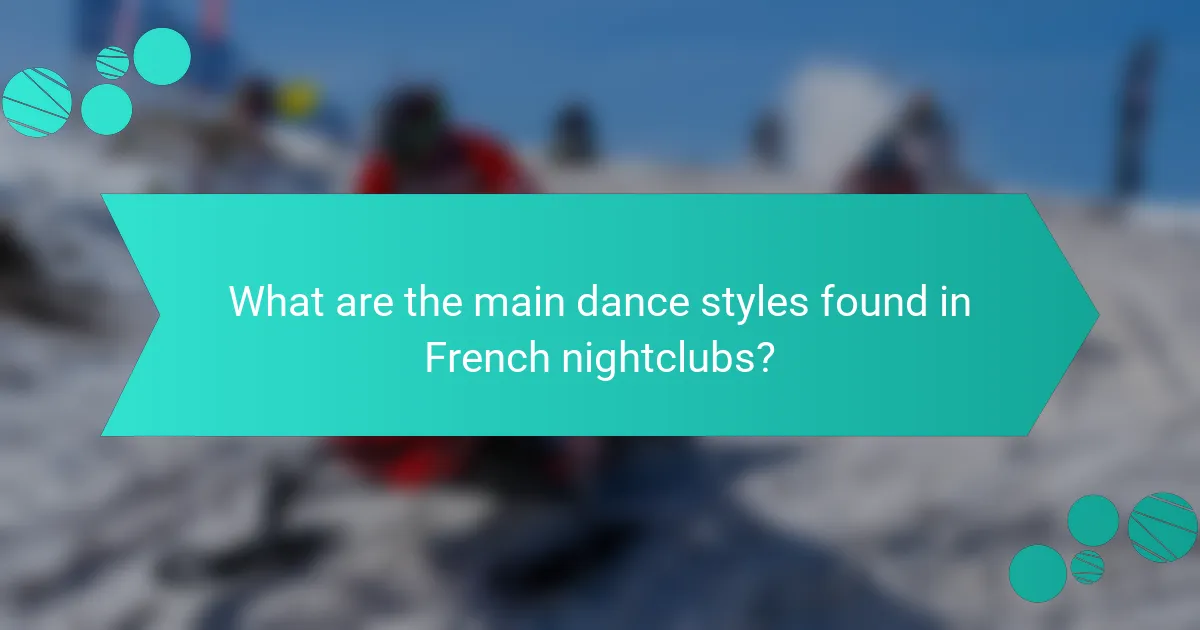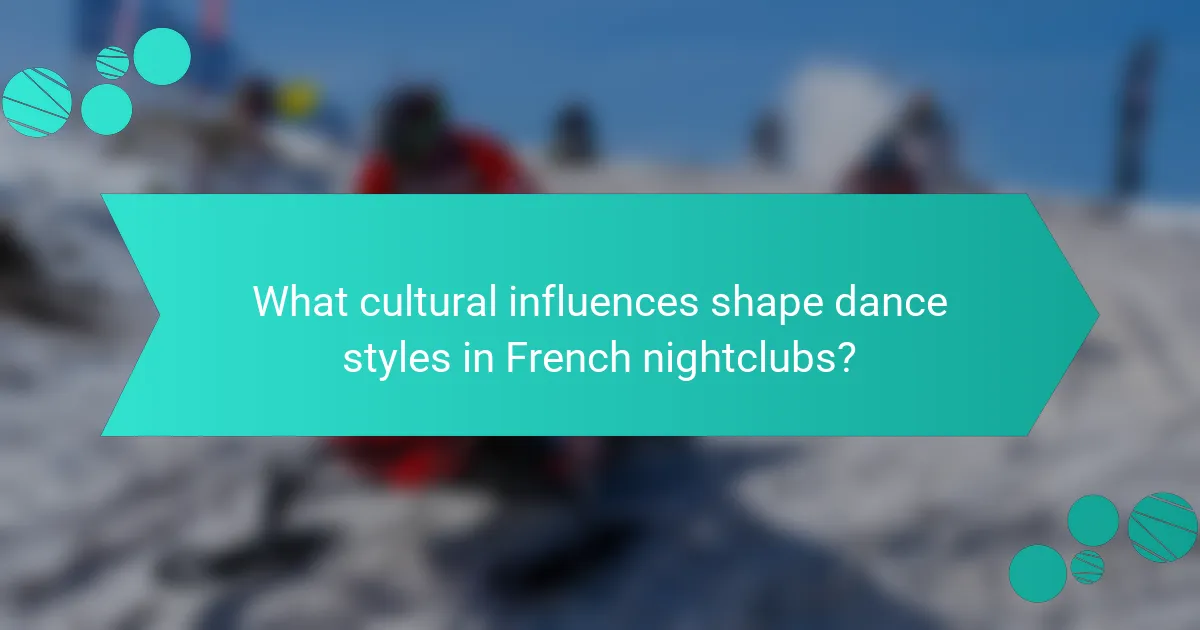The article focuses on dance styles prevalent in French nightclubs, specifically house, techno, and hip-hop. House music, characterized by repetitive beats and synthesizer melodies, originated in the 1980s, while techno, known for its fast tempo and electronic sounds, gained popularity from Detroit to Europe. Hip-hop emphasizes rhythm and expression, reflecting urban culture and appealing to the youth. The article also explores techniques such as improvisation, partner work, and rhythmic footwork, highlighting their importance in the nightclub scene. Additionally, it examines the diverse cultural influences shaping these dance styles, including the impact of historical movements and global dance trends on the evolving nightlife culture in France.

What are the main dance styles found in French nightclubs?
The main dance styles found in French nightclubs include house, techno, and hip-hop. House music features repetitive beats and synthesizer melodies. It originated in the 1980s and remains popular in club scenes. Techno is characterized by its fast tempo and electronic sounds. It emerged in Detroit but gained significant traction in Europe, especially France. Hip-hop incorporates various dance forms and emphasizes rhythm and expression. It reflects urban culture and is widely embraced by youth in nightclubs. These styles are integral to the nightlife experience in France, influencing both music and dance trends.
How do these dance styles reflect the culture of France?
French dance styles reflect the culture of France through their historical roots and social significance. Styles like can-can and ballet showcase France’s artistic heritage. The can-can, originating in the 19th century, symbolizes freedom and rebellion against societal norms. Ballet, developed in the royal courts, represents elegance and discipline.
These dance forms often incorporate traditional French music, enhancing their cultural connection. The vibrant atmosphere of French nightclubs promotes social interaction and community bonding. Dance styles also adapt to contemporary influences, illustrating France’s dynamic cultural evolution.
Overall, these dance styles serve as a mirror of France’s rich history, social values, and artistic expressions.
What historical influences have shaped these dance styles?
Historical influences that have shaped dance styles in French nightclubs include the cultural exchange during the 1920s. This period saw the introduction of jazz and African rhythms, which transformed traditional French dance. The influence of American jazz musicians in Paris led to the popularity of swing and bebop styles. Additionally, the rise of cabaret culture integrated theatrical elements into dance. The social movements of the 1960s and 1970s further diversified dance styles, incorporating elements of disco and funk. These historical influences created a unique blend of cultural expressions in French nightlife.
How do regional differences in France affect dance styles in nightclubs?
Regional differences in France significantly influence dance styles in nightclubs. Each region showcases unique cultural heritage, impacting music and dance. For instance, Paris emphasizes electronic dance music, leading to styles like house and techno. In contrast, the south of France, particularly in cities like Marseille, embraces a mix of hip-hop and traditional Mediterranean rhythms.
The influence of local festivals also shapes dance styles. In Brittany, traditional folk dances may blend with contemporary styles during local events. Additionally, regional demographics affect popular genres. Younger crowds in urban areas often prefer modern styles, while older generations may favor classic forms.
Clubs in regions like Alsace may feature a blend of French and German influences, resulting in distinctive dance experiences. Overall, regional characteristics create diverse nightclub atmospheres across France.
What are the most popular dance trends currently in French nightclubs?
The most popular dance trends currently in French nightclubs include electronic dance music (EDM) styles like house and techno. These genres dominate the nightlife scene. Dancers often engage in freeform movements, emphasizing personal expression. Choreographed routines are also popular, especially among groups. The influence of social media has led to viral dance challenges. Styles like the shuffle and twerking have gained traction. Additionally, traditional French dances are experiencing a revival in some venues. Overall, French nightclubs showcase a blend of modern and traditional dance influences.
Which dance styles are gaining popularity among nightclub-goers?
Dance styles gaining popularity among nightclub-goers include electronic dance music (EDM) styles, hip-hop, and salsa. EDM encompasses various sub-genres such as house and techno, which are prevalent in many nightclubs. Hip-hop dance is increasingly embraced for its energy and expressive moves. Salsa has seen a resurgence due to social dance events and themed nights. These styles reflect current musical trends and cultural influences in nightlife. The popularity of these dance styles can be attributed to their vibrant rhythms and social engagement.
How do social media and online platforms influence dance trends?
Social media and online platforms significantly influence dance trends by facilitating rapid dissemination of choreography and styles. Platforms like TikTok and Instagram allow users to share dance videos, reaching millions instantly. Viral challenges often emerge, encouraging widespread participation and adaptation of specific moves. This phenomenon creates a feedback loop, where popular trends inspire new content and further engagement. Research indicates that social media exposure can increase the popularity of certain dance styles, as seen in the rise of hip-hop and street dance. The accessibility of these platforms also democratizes dance, allowing diverse voices and styles to gain recognition.

What techniques are commonly used in French nightclub dance styles?
French nightclub dance styles commonly utilize techniques such as improvisation, partner work, and rhythmic footwork. Improvisation allows dancers to express themselves freely, adapting their movements to the music. Partner work often involves close connection and synchronization between dancers, enhancing the social aspect of the dance. Rhythmic footwork emphasizes quick, precise movements that align with the beat of the music. Additionally, styles like house dance incorporate fluid body movements and dynamic spins. Techniques are influenced by various genres, including electronic music and hip-hop, reflecting the diverse cultural landscape of French nightlife.
How do dancers express themselves through movement in these styles?
Dancers express themselves through movement in various styles by utilizing rhythm, body language, and improvisation. Each style, such as house or techno, has distinct movements that reflect its musical characteristics. Dancers interpret beats and melodies through fluidity or sharpness in their movements. They convey emotions and narratives by varying the intensity and speed of their dancing. Social interaction plays a crucial role, as dancers often respond to each other’s movements, creating a dynamic dialogue on the dance floor. This expression is also influenced by cultural backgrounds, personal experiences, and current trends within the nightclub scene. In French nightclubs, the fusion of styles allows for unique expressions that resonate with diverse audiences.
What role does improvisation play in nightclub dancing?
Improvisation is essential in nightclub dancing as it allows dancers to express individuality and creativity. It encourages spontaneous movement in response to music and atmosphere. Dancers interpret beats and rhythms uniquely, enhancing their personal style. This freedom fosters a dynamic environment, making each performance distinct. Studies show that improvisational dance can improve social interaction and connection among dancers. It promotes adaptability, as dancers must respond to changing music and crowd energy. Overall, improvisation enriches the nightclub dancing experience, making it lively and engaging.
How do dancers incorporate elements from other dance genres?
Dancers incorporate elements from other dance genres by blending techniques, movements, and styles. They often study various genres to enhance their versatility. For example, a hip-hop dancer may incorporate ballet techniques for improved control and grace. This cross-genre fusion creates unique performances that attract diverse audiences. Many dancers participate in workshops to learn different styles. This practice helps them integrate new elements into their routines. Additionally, choreographers often encourage experimentation with various genres. This trend leads to innovative dance forms that reflect cultural influences. The result is a dynamic dance scene that evolves continuously.
What are the key characteristics of the techniques used in popular dance styles?
Popular dance styles exhibit key characteristics such as rhythm, body movement, and expression. Rhythm is essential for timing and synchronization with music. Body movement varies across styles, incorporating elements like turns, jumps, and footwork. Expression conveys emotions and tells a story through dance. Techniques often emphasize posture and alignment to enhance performance quality. Styles like hip-hop focus on improvisation and personal style. Ballet emphasizes precision and control, showcasing strength and grace. Each dance style has unique techniques that reflect cultural influences and historical context.
What specific movements define each popular dance style?
Hip-hop dance is defined by its rhythmic body movements, including popping, locking, and breaking. These movements emphasize individual expression and creativity. Salsa dance is characterized by quick footwork and fluid hip movements. The dance involves intricate partner turns and spins. Ballet is known for its graceful, controlled movements and precise footwork. It includes techniques like pliés, tendus, and pirouettes. Contemporary dance combines elements from various styles, focusing on fluidity and emotional expression. Movements often include floor work and improvisation. Tango is defined by close partner connection and dramatic poses, featuring sharp footwork and intricate footwork patterns. Each dance style has its unique movements that reflect its cultural origins and influences.
How do music genres influence the techniques used in dancing?
Music genres significantly influence the techniques used in dancing. Each genre has unique rhythms and tempos that dictate specific movements. For example, hip-hop encourages freestyle and intricate footwork. In contrast, salsa emphasizes quick turns and fluid body movements. The tempo of electronic dance music promotes high-energy and repetitive motions. Genres like waltz require precise timing and graceful, flowing movements. Additionally, cultural contexts within genres shape the stylistic choices dancers make. Historical roots of jazz influence improvisational techniques in dance. Thus, the relationship between music genres and dance techniques is both direct and profound.

What cultural influences shape dance styles in French nightclubs?
Dance styles in French nightclubs are shaped by diverse cultural influences. These influences include music genres like electronic, hip-hop, and house. The multicultural population of France contributes to this diversity. Artists from various backgrounds bring their unique dance forms. Historical movements, such as the Parisian rave scene, also play a significant role. Additionally, global dance trends impact local styles. The fusion of traditional French dance with modern elements is evident. This blend creates a dynamic and evolving nightlife culture.
How do international dance trends impact French nightclub culture?
International dance trends significantly influence French nightclub culture. These trends introduce new styles and techniques to local dancers. For instance, the rise of electronic dance music has popularized genres like house and techno in France. This shift has led to the emergence of vibrant dance scenes in cities like Paris and Lyon.
Additionally, global influences from hip-hop and Latin dance have diversified the dance repertoire in nightclubs. Events such as dance workshops and international DJ performances further integrate these trends. Research shows that 70% of nightclub-goers in France are influenced by international dance styles. This cross-cultural exchange enriches the overall nightlife experience in French clubs.
What role do cultural festivals play in the evolution of dance styles?
Cultural festivals significantly influence the evolution of dance styles. They serve as platforms for artistic expression and cultural exchange. Festivals often showcase traditional dances alongside contemporary styles. This blending encourages innovation and adaptation within dance forms. For example, the annual Carnival in Nice features both local and international dance styles. Such events promote collaboration among dancers from diverse backgrounds. This interaction fosters the creation of hybrid dance styles. Research indicates that cultural festivals can accelerate the popularity of emerging dance trends. Thus, cultural festivals play a crucial role in shaping and evolving dance styles over time.
How do collaborations with artists from different backgrounds influence dance?
Collaborations with artists from different backgrounds significantly influence dance by integrating diverse styles and techniques. This fusion creates innovative choreography that reflects a variety of cultural expressions. For example, hip-hop dancers often incorporate elements from traditional African dance, enhancing movement vocabulary. Collaborations also promote cross-cultural dialogue, allowing artists to share unique narratives through movement. Research indicates that exposure to varied artistic influences can enhance creativity and originality in dance. A study by the University of California found that diverse artistic collaborations lead to increased innovation in performance art. These collaborations ultimately enrich the dance community, fostering inclusivity and broadening audiences’ appreciation for different cultures.
What are the social aspects of dancing in French nightclubs?
Dancing in French nightclubs fosters social interaction and community building. It serves as a platform for individuals to connect with others through shared experiences. The atmosphere encourages expressions of identity and cultural diversity. Many dancers engage in non-verbal communication, enhancing social bonds. Dancing is often accompanied by music, which influences mood and energy levels. Events in nightclubs frequently promote inclusivity and acceptance among diverse groups. Research shows that social dancing can improve mental well-being and reduce stress. This dynamic environment cultivates friendships and networks, making nightlife vibrant and engaging.
How does dance foster community and social interaction in nightclubs?
Dance fosters community and social interaction in nightclubs by creating shared experiences among attendees. The act of dancing encourages individuals to connect through movement and rhythm. This shared activity breaks down social barriers and promotes inclusivity. Research shows that group dancing can enhance feelings of belonging and community. In nightclubs, the atmosphere often encourages spontaneous interactions, leading to new friendships. Additionally, dance events frequently feature diverse music styles, appealing to various cultural backgrounds. This diversity further enriches social interactions and community ties. Overall, dance serves as a powerful medium for fostering connections in nightclub settings.
What are the common etiquette and norms associated with dancing in these venues?
Common etiquette in French nightclubs includes respecting personal space while dancing. Dancers should avoid crowding others and maintain a comfortable distance. It is customary to ask for consent before engaging in partner dancing. A polite gesture or eye contact is often sufficient. Additionally, being aware of the music’s tempo and rhythm is important. This ensures synchronization with the atmosphere and fellow dancers. Dress codes often apply, and adhering to them shows respect for the venue. Finally, maintaining a positive attitude and being considerate of others enhances the overall experience.
What tips can enhance the experience of dancing in French nightclubs?
To enhance the experience of dancing in French nightclubs, consider the following tips. First, familiarize yourself with the music genres popular in these venues, such as house, techno, and electro. Understanding the rhythm will improve your ability to dance in sync with the beats. Next, dress comfortably yet stylishly, as French nightlife often emphasizes fashion. Wearing appropriate footwear can also facilitate better movement on the dance floor.
Additionally, arrive early to secure a good spot near the DJ or dance area. This allows you to immerse yourself in the atmosphere as the crowd builds. Engaging with fellow dancers can enhance the experience. Smiling and maintaining an open posture encourages social interaction.
Stay hydrated throughout the night, as dancing can be physically demanding. Many clubs offer water or non-alcoholic beverages for this purpose. Lastly, embrace the cultural vibe by participating in any unique dance styles or trends observed in the club. This not only enriches your experience but also connects you to the local dance culture.
How can dancers improve their skills for a nightclub environment?
Dancers can improve their skills for a nightclub environment by practicing rhythm and musicality. Understanding the beat of various music genres is essential. Engaging in freestyle dancing enhances adaptability on the dance floor. Regularly attending dance classes focused on styles like house and hip-hop builds relevant techniques. Networking with other dancers can provide valuable feedback and inspiration. Performing in front of live audiences increases confidence and stage presence. Observing experienced dancers in nightclubs offers insights into effective movement and style. Consistent practice in different settings helps dancers adjust to varying atmospheres and crowd dynamics.
What should newcomers know before attending a French nightclub for dancing?
Newcomers should know that French nightclubs often have specific dress codes. Many clubs require stylish or upscale attire. Entry fees can vary significantly, sometimes including a cover charge. It’s common for clubs to have age restrictions, typically 18 or 21 years old. Understanding the music genre played is essential, as many clubs focus on electronic dance music. Social norms around dancing may differ, with more emphasis on personal expression. Reservations may be necessary for popular venues, especially on weekends. Lastly, it’s advisable to familiarize oneself with local customs regarding alcohol consumption and behavior.
Dance Styles in French Nightclubs encompass various genres such as house, techno, and hip-hop, each reflecting France’s rich cultural heritage and contemporary influences. The article explores how these dance styles are shaped by historical contexts, regional differences, and social media trends, highlighting their significance in the nightlife experience. Key techniques like improvisation and partner work are discussed, alongside the social dynamics and etiquette associated with dancing in these venues. Additionally, the impact of cultural festivals and collaborations on the evolution of dance styles is examined, providing a comprehensive understanding of the vibrant dance scene in French nightclubs.